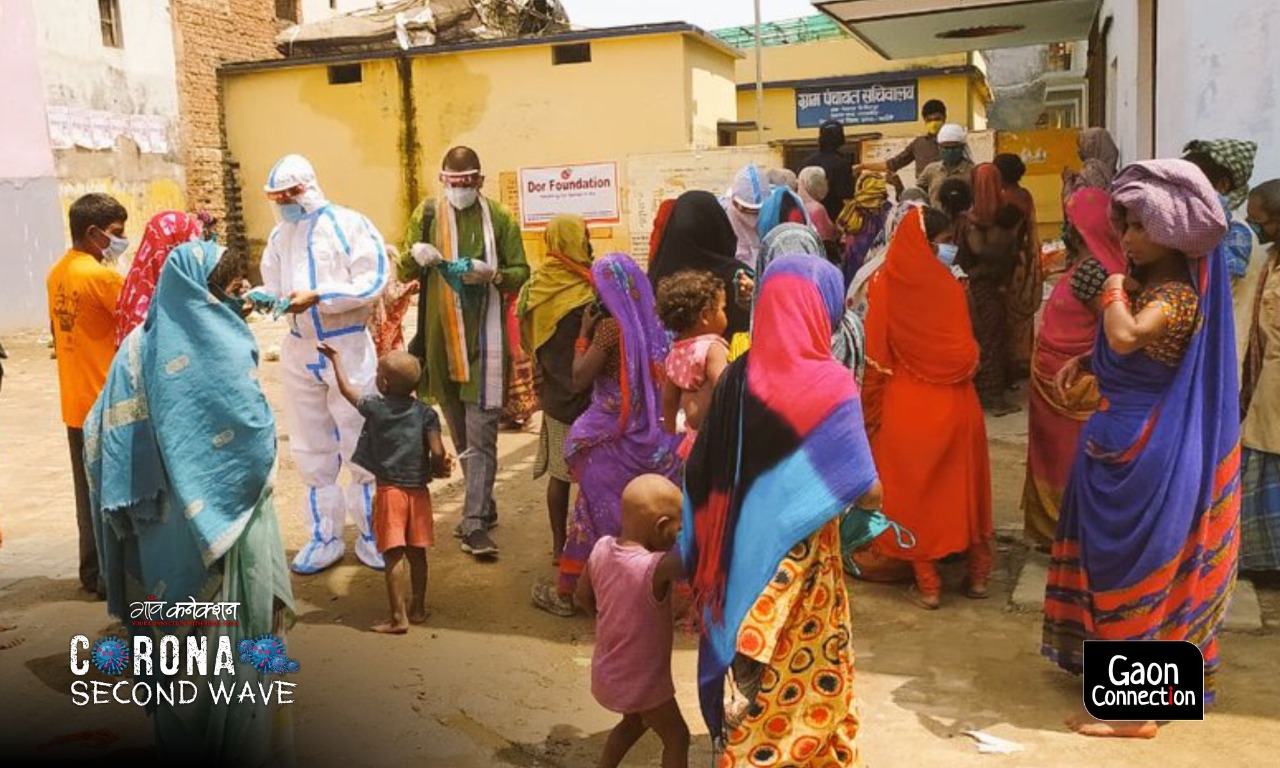Rural India, where two-thirds of Indians live, did not escape the fury of the second wave of the COVID19 pandemic. Latest data collated and analysed by the Centre for Science and Environment (CSE), a New Delhi-based environmental research organisation, shows that every second COVID case and death recorded in the country in May 2021 was from rural districts.
The ‘State of India’s Environment 2021’, the latest data report by CSE, goes on to note that in the first 26 days of May, globally, India accounted for every other new COVID-19 case and every third death due to the infection. This also means every fourth case reported in the world last month was from rural India.

Gaon Connection has been consistently reporting on the rise of the COVID infections in villages across the country. On the one hand, there was a sharp increase in cases registered in rural India, and on the other, there was a shortage of testing facilities, COVID wards and basic health services.
Also Read: Rural Uttar Pradesh in a fever of trouble
Villagers and health sector experts claim that COVID deaths recorded in rural India are far lesser than the actual number of deaths. Whereas the district administration claimed some were ‘natural deaths’, family members insist they died of COVID-like symptoms.
Because of lack of testing and fear of testing, among other things, it is hard to ascertain the real cause of the rising deaths in rural districts. Even then, the available data paints a grim picture, as reflected in the recent report.
Also Read: There’s more to India’s COVID19 death toll than meets the eye
Shortage of rural healthcare staff
What makes the COVID assault on rural India extremely difficult to handle is the acute shortage of basic healthcare services and infrastructure in villages.
The rural healthcare system in India operates at three levels — sub-centre, primary health centre (PHC), and community health centre (CHC). A sub-centre covers a population of 5,000 people, a PHC covers 30,000 people and the CHC covers 120,000 people.
However, the ‘State of India’s Environment 2021’ report shows the gaping holes in rural health infrastructure. It found that as of March 2020, there is a shortfall of 14.1 per cent ANMs (auxiliary nurse midwives), 35 per cent male health workers and 7 per cent doctors at sub-centre and PHC level.
The situation is worse at the CHC level that has a shortfall of 78.9 per cent surgeons, 69.7 per cent obstetricians & gynecologists, 78.2 per cent physicians and 78.2 per cent pediatricians.
This works out to a total shortage of 76.1 per cent specialists at CHC level, where rural India seeks specialised healthcare.

On May 29, Gaon Connection reported how a number of sub-centres and PHCs in rural Uttar Pradesh were dilapidated and non-functional, with leaking roofs, missing doors and few staff.
Also Read: Leaking roofs, missing doors, weeds everywhere and few staff: Rural health centres in shambles
The CSE’s recent report notes that India needs at least 38 per cent more CHCs, which is the first level of health infrastructure where the rural population gets access to specialist doctors and radiographers.
It also informs that at the all-India level, the country needs 24 per cent more sub-centres and 29 per cent more PHCs to meet the shortfall. At present, rural health infrastructure has a rampant shortage of doctors and specialists such as lab technicians and radiographers in rural health centres.
Based on an investigation, Gaon Connection had reported on May 6 how several district hospitals where rural India seeks medicare, have inadequate, faulty or no ventilators at their disposal. There is also a severe shortage of trained technicians to operate them.
Also Read: COVID-19 invades rural India; district hospitals struggle with faulty or no ventilators at all
Acute shortage of human resources
Data analysis by the CSE shows that Puducherry and Mizoram have no specialist doctors available at the CHC level. Gujarat and Tripura have a 99 per cent shortage of such doctors at CHCs. Meghalaya and Madhya Pradesh have 96 per cent shortfall each (see bar graph).

Most Indian states also have a shortage of radiographers at CHCs. Bihar has reported the highest shortfall at 95 per cent followed by Kerala at 94 per cent, Nagaland at 86 per cent and Uttarakhand at 84 per cent.
At the all-India level, there is a 56 per cent shortfall in radiographers at CHCs.
Similarly, there is a shortage of doctors at PHCs. The Union territory of Ladakh has a shortfall of 69 per cent doctors at PHCs followed by 51 per cent at Chhattisgarh. Uttar Pradesh has reported only a 4 per cent shortage of PHC doctors. At the all-India level, there is a 7 per cent shortfall in PHC doctors.
Meanwhile, there is a shortage of lab technicians both at PHCs and CHCs, with the highest shortfall in Himachal Pradesh (93 per cent) followed by Uttarakhand at 81 per cent and national capital Delhi at 80 per cent.
At the all-India level, there is a 35 per cent shortfall in lab technicians at CHCs and PHCs.
That healthcare infrastructure in rural India is sorely lacking is well known, but in the last month, the ineptitude has been felt like never before.
Also Read: When COVID-19 reached remote, mule-track villages in the upper reaches of Uttarakhand



















